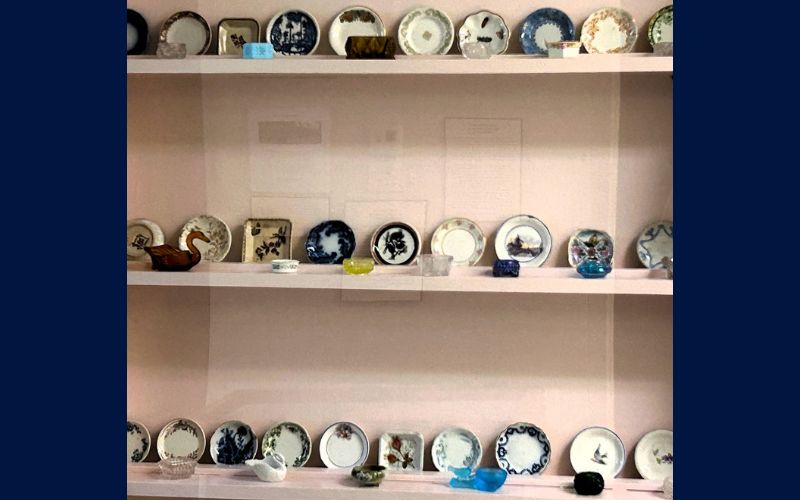By: Mary E. Mortimer
The Logan County Museum hallway features a butter pat and salt cellar exhibit donated by the Shoots family. This collection was started by Dorothy Shoots of Zanesfield in 1946. Her aim in starting the collection was to collect something “inexpensive and unusual that required little storage space and was interesting to most women.” She accumulated over two hundred and eighty butter pats by trading with other collectors, receiving them as gifts, and purchasing them from various sources.
Dorothy’s daughter, Nancy Shoots Johnson, began collecting salt cellars while she was in high school. She accumulated over four hundred salt cellars as gifts from family and friends. The salt cellars vary in size and shape and are from several different countries. Most of the salt cellars are porcelain and glass, while others are made of wood and stone. Our exhibit features only a fraction of the butter pats and salt cellars we have in our collection.
According to the Journal of Antiques & Collectibles, “In the United States and many parts of Europe butter pat plates were primarily used in the 1800s and into the early 1900s in the homes of affluent citizens who had elaborate dinnerware sets for formal dining. Each dinner guest was given his or her own butter pat plate on which to put a pat (or lump) of butter. The butter itself was often molded or stamped to form patterns, such as flowers, on the butter’s surface. Each individual lump of butter was then placed on a butter pat plate belonging to a specific guest.
Butter pat plates produced in the 1800s and early 1900s were primarily made out of either porcelain or sterling silver, and some were made of glass. They were produced as part of dinner service sets or to match existing dinner service sets. Each tiny plate was typically less than three inches square and held either one or two pats of butter at a time.
Some butter pat plates were simple square plates a bit larger than a lump of butter. However, Victorian families preferred elaborate patterns and designs. That led to the development of shapes and patterns which included shell or fan-like plates, as well as round plates.
The colors and designs on the butter pat plates also got more elaborate as time went on. Floral designs were quite common. In some cases, the butter pats themselves were shaped and colored to resemble flowers. In other cases, the butter pats were square or round and featured pictures of flowers in their centers or floral patterns around their edges. Other popular butter pat themes included animals and birds.
As you might expect, many of the most popular butter pat producers are the “big name” porcelain producers which were historically popular for their dinnerware and decorative pieces. Among the most common and popular types of butter pats are Haviland, Majolica, and Waverly. Of Haviland’s up to 60,000 different patterns, most included butter pats as part of a place setting.”
Antique & Auction News reported the following on salt cellars, “As early as Classical Roman Times, salt was considered a dining luxury and available in only wealthier homes. Salt was purchased in smaller quantities and placed in tabletop vessels called salt cellars, salt dishes, or simply salts.
Salt cellars came in many forms, shapes, sizes, and materials. Usually, they were open salts, but some were lidded salts. Some salt cellars were footed. They were made from materials such as glass, porcelain, clay, pewter, or silver and came in varying colors, shapes, and sizes, ranging from plain to whimsical.
Some dining tables used a larger master salt, which was passed around the table from diner to diner. Others were smaller individual salts, with a smaller salt cellar placed beside each dining service.
Salt cellars were commonly used throughout the Victorian era and even into the early 20th century when they were replaced by the saltshakers used today.”
Visit the Logan County History Center at 521 E. Columbus Ave., Bellefontaine, Ohio 43311, to learn more interesting aspects of Logan County History.
The History Center is open for tours Wednesday – Sunday from 1:00 pm to 4:00 pm.
















